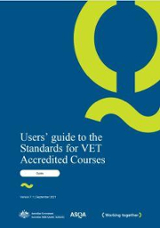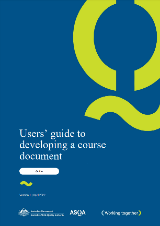- Home
- Course accreditation
- More support—Course accreditation
More support—Course accreditation
ASQA’s role
We are committed to:
- providing a timely and responsive service
- keeping applicants informed throughout the process
- being open and transparent.
Our role as a regulator means we cannot teach applicants how to follow the standards. We cannot provide consultancy services.
ASQA may seek technical advice from the relevant industry when accrediting courses.
User’s guide to the Standards
 Find out about requirements for course accreditation using our guide.
Find out about requirements for course accreditation using our guide.
Our guide includes:
- explanations of each of the standards
- tips on how to collect and present information
- real case studies.
See Users’ guide to the Standards
User’s guide to developing a course document
 You need to develop your course using the national course document template.
You need to develop your course using the national course document template.
The national course document captures all the information about your course.
If your course is accredited, your course document will be used by RTOs as the basis for training and assessment.
See User’s guide to developing a course document
Visit ASQA’s YouTube channel and subscribe to watch our latest videos.
The national register
The national register lists all nationally endorsed training package qualifications, units of competency and accredited courses in Australia.
Glossary
Legislation and standards
Course accreditation is governed by the following act and standards:
- National Vocational Education and Training Regulator Act 2011
- Standards for VET Accredited Courses 2021
- Standards for VET Regulators 2015
- Standards for Training Packages 2023
- Australian Qualifications Framework
Contact us
If you have a question or need more information:
Related links
Share
